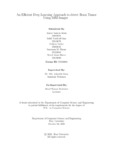| dc.contributor.advisor | Alam, Md. Ashraful | |
| dc.contributor.advisor | Rodoshi, Ahanaf Hassan | |
| dc.contributor.author | Islam, Annur Tasnim | |
| dc.contributor.author | Apu, Sakib Mashra | |
| dc.contributor.author | Sarker, Sudipta | |
| dc.contributor.author | Hasan, Inzamam M. | |
| dc.contributor.author | Shuvo, Syeed Alam | |
| dc.date.accessioned | 2022-09-08T05:03:34Z | |
| dc.date.available | 2022-09-08T05:03:34Z | |
| dc.date.copyright | 2021 | |
| dc.date.issued | 2021-10 | |
| dc.identifier.other | ID 18101021 | |
| dc.identifier.other | ID 21141078 | |
| dc.identifier.other | ID 18101631 | |
| dc.identifier.other | ID 21241084 | |
| dc.identifier.other | ID 21141080 | |
| dc.identifier.uri | http://hdl.handle.net/10361/17179 | |
| dc.description | This thesis is submitted in partial fulfillment of the requirements for the degree of Bachelor of Science in Computer Science, 2021. | en_US |
| dc.description | Cataloged from PDF version of thesis. | |
| dc.description | Includes bibliographical references (pages 33-35). | |
| dc.description.abstract | A brain tumor is the development of mutated cells in the human brain. Many di er-
ent types of brain tumors exist nowadays. According to researchers and physicians,
some brain tumors are non-cancerous while some are life-threatening. In most cases,
the cancer is detected at the last stage and it is di cult to recover. This increases
the mortality rate. If this could be detected in the initial stages, then a lot more
lives could be saved. Nowadays, brain tumors are being detected through auto-
mated processes using arti cial intelligence algorithms and brain image data. In
this research, we propose an e cient approach to detect brain tumors using Mag-
netic Resonance Imaging (MRI) data and a deep neural network. The proposed
system comprises several steps - preprocessing and classi cation of brain MRI im-
ages. Furthermore, we analyzed the performances of di erent deep neural network
architectures and optimized them with an e cient one. The proposed model en-
ables classifying brain tumors e ectively with higher accuracy. To commence, we
collected data and classi ed it using the ResNetl0l, ResNet50, InceptionV3, VGG19,
and VGG19 architectures. As a consequence of our analysis, we obtained an accu-
racy rate of 96.72% for VGG16, 96.17% for ResNet50, and 95.55% for InceptionV3.
Then, using these three top classi ers, we constructed an ensemble model and ob-
tained an overall accuracy rate of 98.60% using EBTDM (Explainable Brain Tumor
Detection Model). | en_US |
| dc.description.statementofresponsibility | Annur Tasnim Islam | |
| dc.description.statementofresponsibility | Sakib Mashra Apu | |
| dc.description.statementofresponsibility | Sudipta Sarker | |
| dc.description.statementofresponsibility | Inzamam M. Hasan | |
| dc.description.statementofresponsibility | Syeed Alam Shuvo | |
| dc.format.extent | 35 pages | |
| dc.language.iso | en | en_US |
| dc.publisher | Brac University | en_US |
| dc.rights | Brac University theses are protected by copyright. They may be viewed from this source for any purpose, but reproduction or distribution in any format is prohibited without written permission. | |
| dc.subject | Brain Tumor | en_US |
| dc.subject | MRI | en_US |
| dc.subject | Deep Neural Network | en_US |
| dc.subject | VGG | en_US |
| dc.subject | ResNet | en_US |
| dc.subject | Efficient- Net | en_US |
| dc.subject | Inception | en_US |
| dc.subject | Ensemble | en_US |
| dc.subject | EBTDM | en_US |
| dc.subject.lcsh | Neural networks (Computer science) | |
| dc.subject.lcsh | Image processing -- Digital techniques | |
| dc.title | An Efficient deep learning approach to detect Brain Tumor using MRI images | en_US |
| dc.type | Thesis | en_US |
| dc.contributor.department | Department of Computer Science and Engineering, Brac University | |
| dc.description.degree | B. Computer Science | |

